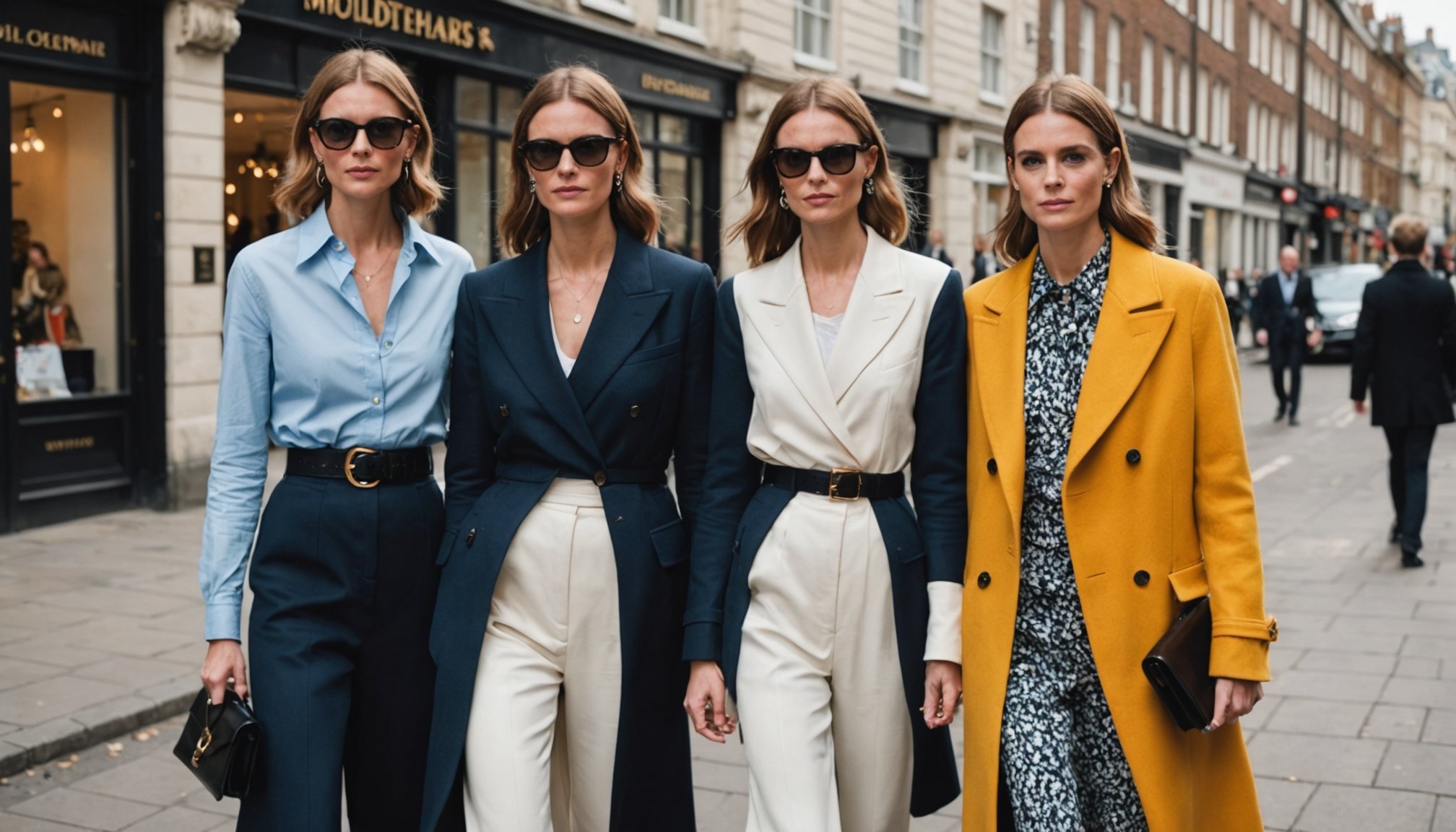Understanding British High Street Fashion
British High Street Fashion is renowned for its accessibility and on-trend styles, making it a staple in many wardrobes. It blends affordability with the latest fashion trends, offering an inclusive platform for diverse styles. Key characteristics often include a mix of classic and contemporary aesthetics, practical designs, and an emphasis on style basics that cater to a wide audience. This dynamic manner of dressing allows individuals to express their personality without significant financial commitment.
Many people misconceive high street fashion as inferior to high-end fashion. However, both possess unique qualities. High street fashion is characterised by its accessibility and quick adaptation to fashion trends. In contrast, high-end fashion boasts exclusivity and detailed craftsmanship. Yet, high street fashion is influential due to its widespread reach and capability to dictate everyday style basics.
Also read : Unlock Chic Layering Secrets: The Definitive Guide to Stylish Wardrobes for Unpredictable UK Weather
Understanding these differences enriches the appreciation for fashion diversity. The significance of British High Street Fashion lies in its role as a trendsetter and its adaptability, proving that stylish clothing doesn’t have to come at a premium cost. By embracing its essence, fashion enthusiasts can continuously refresh their looks and stay attuned to the ever-evolving world of fashion trends.
Principles of Elevating Fashion
Transitioning from casual to couture involves embracing fashion transformation through a keen understanding of styling techniques and couture elements. An essential principle is recognising the importance of tailoring and fit. A well-tailored garment speaks volumes, enhancing the wearer’s physique and projecting finesse. An impeccable fit can effortlessly change an ordinary ensemble into a statement piece, ensuring a polished and refined appearance.
Also to see : Master the art of autumn layering: the definitive guide to choosing ideal tights for cozy uk style
Selecting the right silhouettes is equally crucial. Different body types benefit from varied cuts; understanding this aids in choosing silhouettes that flatter and elevate everyday looks to a couture level. Classic silhouettes remain timeless, while bold, geometric options add modernity and interest.
Moreover, incorporating couture elements involves paying attention to details. Couture fashion is known for its meticulous attention to detail—consider subtle embellishments or intricate stitching that set high-end pieces apart.
To encapsulate the transition into couture fashion, consider the elements that define fashion transformation. Simplicity combined with thoughtful detailing and precision in fit creates an elevated style. Each piece selected for your wardrobe should contribute to an overall harmonious look while allowing personal expression. Through these principles, anyone can embrace the transformative journey from casual to couture.
Key Fabrics and Textiles
Understanding the nuances of fashion fabrics is vital for transforming one’s style from high street to couture. Essential textiles like cotton, wool, and silk form the backbone of many wardrobes, offering different finishes and levels of comfort. While high street fashion often utilises these basic fabrics, opting for blends that ensure affordability, their couture counterparts focus on the quality and craftsmanship inherent in luxurious materials.
Differences between high street and high-end fabric qualities are primarily in the sourcing and touch. Couture materials such as cashmere or fine silk are meticulously selected for their superior texture, longevity, and comfort. Where high street options strive to replicate these traits, they might miss the exquisite detailing that defines high-end luxury.
Incorporating luxury textiles into everyday wear need not be daunting. Small adjustments, like choosing a silk scarf or a cashmere sweater, can elevate a look. Accessories crafted from premium materials offer a touch of sophistication without requiring a complete overhaul of one’s entire wardrobe. By strategically adding these elements, individuals can achieve a refined aesthetic synonymous with high fashion while maintaining their personal style essence.
Notable Designers and Inspirations
Diving into the realm of influential fashion designers offers a gateway to understanding how couture fashion continues to evolve. Designers like Vivienne Westwood and Alexander McQueen have been instrumental in shaping not only the aesthetics of couture but also in bridging it with British High Street Fashion. Their bold, edgy styles often become the blueprint for inspirational styles and mainstream adaptations.
Designer collaborations between high street brands and luxury labels are redefining contemporary fashion. For example, H&M’s partnerships with designers such as Balmain and Versace have made high-end looks accessible to a broader audience. These collaborations offer exclusive styles without the often prohibitive costs associated with high-end brands, allowing fashion enthusiasts to experience couture-like designs through designer collaboration lines.
Finding inspiration in designer collections involves focusing on the recurrent themes and materials that resonate personally. Consulting designer collections can stimulate creativity in everyday styling. Integrating elements like unique textures or avant-garde designs into personal wardrobes can refresh one’s style effectively. Exploring visual presentation and narrative further enriches personal style development, making couture more relatable and achievable for fashion aficionados.
Practical Styling Techniques
Achieving a couture aesthetic often hinges on mastering practical styling tips that incorporate creative layering and the right fashion accessories. Layering isn’t just about warmth; it can dramatically transform an outfit. For instance, pairing a chic blazer over a casual top can elevate your ensemble. Accessories further aid this transformation—think bold jewellery, stylish bags, or statement belts that highlight your outfit combinations.
When it comes to colour palettes and patterns, choosing the right ones can make your look pop. Neutral tones can be enhanced with vibrant accents, while patterns such as stripes or checks can break the monotony, adding a dynamic edge to your attire.
Statement pieces are game-changers in any wardrobe. Whether it’s a brightly coloured coat or an intricately designed scarf, these items draw attention and offer a focal point in your ensemble. By rotating these pieces, you keep your look fresh and engaging without a complete wardrobe update.
Successfully blending these techniques gives your style a refined edge and ensures you’re dressed to impress—whether you’re headed to an art exhibition or a lunch date. Remember, styling is an expressive art, elevating from ordinary to extraordinary.
Visual Storytelling: Before-and-After Transformations
Visual aids play an essential role in demonstrating fashion makeovers, providing immediate context to style evolutions. They allow enthusiasts to grasp how subtle changes can result in dramatic sartorial transformations. The proverbial ‘seeing is believing’ becomes particularly poignant when analysing fashion examples that visually capture the journey from mundane to magnificent.
Consider a simple T-shirt and jeans ensemble. By layering with a tailored jacket, adding a statement necklace, and opting for stylish shoes, a casual look can be elevated to couture excellence. Highlighting these transformations with visual aids makes the styling process tangible and inspiring, offering practical guidance for similar personal attempts.
Successful before-and-after case studies illustrate the impact of strategic alterations: swapping basic materials for higher-quality textiles, experimenting with bold prints, or integrating unique accessories. These examples unify elements of sophistication and creativity to depict achievable upgrades, demonstrating that fashion transformation doesn’t require a complete overhaul.
Common features in high-end makeovers often include attention to tailoring, the inclusion of texture contrasts, and cohesive colour palettes. Such transformations go beyond wardrobe changes; they empower individuals to explore innovative trends while enhancing personal expression with confidence.
Dressing for Various Occasions
Exploring versatility in high street fashion elevates your style for different events. With the right approach, even the most ordinary wardrobe can transition from casual lunches to evening soirées. Understanding the nuances of occasion styling ensures your outfit is always on point, whether formal or relaxed.
To achieve this adaptability, integrate versatile fashion staples like tailored blazers and structured skirts. Such pieces seamlessly transform high street looks into couture-ready ensembles. It’s crucial to consider fabric texture and fit, adding layers or altering silhouettes to define their presence.
Balancing comfort and fashion involves strategic choices in clothing and accessories. For instance, selecting a modest pair of heels or a sleek clutch can effortlessly elevate attire from day to night. Moreover, the art of subtle coordination—harmonizing colours and incorporating unique yet elegant jewellery—adds sophistication that stands out in any setting.
Ultimately, fostering a wardrobe primed for various occasions expands one’s styling potential. It fortifies personal style while ensuring practical utility. This approach promotes a savvy balance of comfort, style, and adaptability, empowering fashion enthusiasts to confidently attend any event with couture readiness.
Expert Recommendations and Resources
Navigating the world of fashion requires a blend of knowledge and practical insights. To refine your style and keep abreast of trends, consider exploring fashion resources like books and online platforms that delve into both historical and contemporary fashion trends. Noteworthy reads include “The Little Dictionary of Fashion” by Christian Dior, providing timeless tips on elegance, and “The Fashion System” by Roland Barthes, offering an academic perspective on clothing’s societal role.
Online platforms such as The Business of Fashion and Vogue’s Style Manual offer expert advice to enhance your style journey. These resources help decode complex fashion principles, blending tradition with modernity. Engaging with industry experts through podcasts or webinars can further enrich your understanding—providing styling guides that are practical and enriched with firsthand insights.
Continual education in fashion is crucial. Attending workshops or courses helps in mastering styling techniques and couture elements. This dedication to learning fortifies your ability to create a cohesive personal style, seamlessly blending style basics with couture readiness. Embrace these expert recommendations to build a versatile, sophisticated wardrobe that reflects personal flair and adaptation to evolving fashions.








